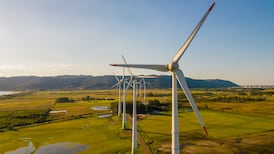In what is seen as a major milestone on Ireland’s energy decarbonisation journey, the Government has decided that Eirgrid is to be both the owner and operator of the transmission system that will be required to connect offshore wind energy to the electricity grid.
The new policy identifies the centralised model, with transmission assets to be planned, developed, owned and operated by Eirgrid, as the one that will deliver maximum societal benefits. A phased transition from the existing decentralised offshore transmission system model will be required over the course of the decade. This will coincide with the three offshore Renewable Energy Support Scheme (RESS) auctions scheduled to take place over the period.
In the first phase it is envisaged that the developers of the offshore renewable projects that are successful in the first RESS auction will develop the associated offshore transmission system requirement. In the following phase the planning and development of the offshore transmission system may be carried out by either renewable energy developers or Eirgrid. In the final phase, the system will be exclusively developed by Eirgrid.
According to Eirgrid chief executive Mark Foley, making this policy decision in advance of the development of the offshore generation assets was a smart move. “It is far better than trying to decide on something when the system has already evolved organically,” he says. “The result is that they effectively have a blank canvas. It’s a really good strategy. The department has been working on it for the last two years and they have taken advantage of this opportunity to get it right for government and the country.”
He also believes the phased nature of the policy is the best approach to take. “It recognises the reality that there are lots of projects in the Irish Sea which have been subject to a lot of preliminary work by developers. It really is very well thought out.”
Role of wind
Offshore wind will play a critical role in Ireland achieving its 2030 target of having 70 per cent of electricity generated from renewable sources and the 2050 net zero carbon target. “Ireland has a phenomenal natural resource in the Atlantic winds which blow across the island,” says Foley. “We don’t need to prove the hypothesis. We already have 5,000MW of onshore wind on the island. On a windy day there is can be up 70-75 per cent renewables on the system. Nobody is doubting the potential of the resource.”
Indeed, Ireland’s wind energy resources are more than sufficient to meet its own needs. “We have an opportunity to use it to help other countries on their decarbonisation journey, particularly countries in Europe.”
Realising that potential requires the right transmission system. “The best analogy for the transmission system is the motorway network, except that our system is used to shift vast volumes of electricity around the country. Eirgrid is responsible for the planning and operation of that system. The subtle difference with the new policy is that the onshore transmission assets are owned by the ESB. As we look to the future with offshore wind, our remit will extend into ownership as well. It’s not a radical departure.”
That centralised model will cut out duplication of effort as well as delivering other benefits. “It will mean that the offshore transmission system is developed in a carefully planned and co-ordinated way that ensures the state is a significant beneficiary of offshore wind development. When you are talking about a grand plan of this scale, it makes sense to have a national overarching policy in relation to it. The policy also recognises the existing ecosystem in the sector which includes some of the very best companies in the world who are masters of offshore wind generation technology.”
Avoiding duplication
The alternative would see individual developers putting their own transmission assets in place resulting in a costly duplication of effort. “Allowing piecemeal development like that would have the potential to be suboptimal,” says Foley.
“This allows the developers to do what they do best,” he continues. “It’s incredible to see what these companies do with nature to produce energy. These guys do amazing things with technology. The transitional approach doesn’t interfere with the great work that has already been done on the east coast.”
The policy also offers certainty to offshore developers. “It’s a very simple model. Developers only have one door to knock on when it comes to discussing the transmission system. Some would argue that we should have moved on offshore more quickly. But I think we have got it right. The technology is much more advanced now and further up the innovation curve. When it does land, the price of the energy will be very competitive.”










